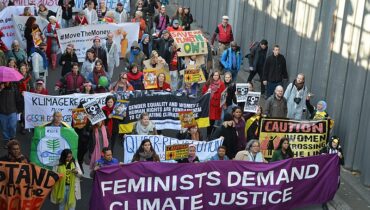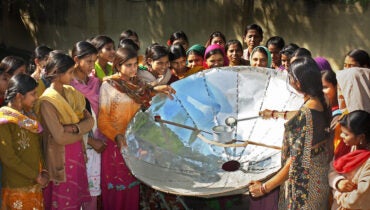Climate change is an existential threat that burdens all of humanity, but not equally. From war-torn Ukraine to the drought-affected Sahel, climate change creates hostile conditions that wreak havoc on agricultural production and access to natural resources, resulting in loss of livelihoods, poverty, instability, and violent conflict. Women and girls experience the greatest impacts of the climate crisis, which amplify existing gender inequalities and pose unique threats to their livelihoods, health, and safety. Over 80 percent of people currently displaced by climate-related events are women and girls, and they often face greater difficulties in absorbing and recovering from climate shocks.
At the same time, women are leading climate solutions – as activists, decision-makers, and peacebuilders on the frontlines of adaptation efforts. However, the exclusion of women in climate decision-making roles, limited access to climate funds and climate-earmarked overseas development assistance (ODA), and fewer opportunities in climate-smart agriculture hinder their contribution to an inclusive and just climate transition.
“Equity in climate action also means equity in the actors behind it. Women must be leaders in combating climate change because it disproportionately affects women and girls.” – Ambassador Lana Nusseibeh
The UN Secretary General called findings from the Intergovernmental Panel on Climate Change (IPCC) a “code red for humanity.” The most recent assessment report makes clear that time is running out to avert “irrevocable damage” caused by climate change. When leaders gather in Dubai in November for the 28th annual Conference of the Parties of the United Nations Framework Convention on Climate Change (COP28), they must come together to accelerate efforts to address the climate crisis. As the largest annual conference on climate action, COP is an important moment for world leaders, civil society, the private sector, and climate activists to unite on bold, innovative, and ambitious solutions.
“We want COP28 to be a COP of Action, a COP of Impact, and a COP for All. But there is no way to achieve any of this vision without putting gender equality front and center.” – Dr. Sultan Al Jaber
Here are four key areas of action to advance inclusive climate action in the lead-up to COP28.
- Ensure the Loss and Damage Fund is a gender-sensitive and transformative platform for inclusive and just climate action.
After sustained advocacy by climate justice movements at COP27, governments came together to establish a historic Loss and Damage Fund – a major breakthrough in acknowledging the vast inequities of climate change impacts and the need to channel resources to countries and communities most affected. Gender-responsive implementation will be critical. The agreement tasks a Transitional Committee of 24 countries with operationalizing the fund, including determining which countries should contribute resources and how financing will be collected and distributed.
Ahead of COP28, the Transitional Committee should ensure that the Fund is inclusive, transparent, and guided by the needs and priorities of those most impacted by climate change – especially Indigenous women and women in the Global South. Innovative sources of finance should be identified and scaled to match country pledges, including additional public and grant-based financing. Critically, women should be centrally engaged in the design, management, and disbursement of the new Fund and it must be responsive to specific losses suffered by women.
- Increase and enable women’s access to inclusive climate finance.
Gender-responsive climate financing is critical to a just transition. Currently, only 0.01% of funding worldwide supports projects that address both climate and women’s rights, and the more fragile a country is, the less climate finance it receives. Other large-scale financing projects led by the Green Climate Fund (GCF) and distributed to large national and international institutions and multilateral development banks (UNDP, EBRD, ADB, and the World Bank) have a specific mandate to support countries most vulnerable to climate impacts, including least developed countries, small island developing states, and African nations. However, the GCF, along with the Global Environment Facility (GEF), Adaptation Fund, and the HBAR Foundation Sustainable Impact Fund (SIF), need to develop better strategies to reach local-level actors who lead climate adaptation solutions.
At COP28, the international community – across public, philanthropy, and private sectors – must deliver on direct financing that supports women most impacted by climate change. President Biden’s recent pledge to provide an additional $1 billion to the GCF is a strong step toward a just transition, but it needs to be matched with a gender-inclusive implementation plan to reach those most affected. In addition to addressing gender barriers within funding mechanisms, tailored support should be provided to women and civil society organizations on the frontlines of the climate crisis about what funding is available and how to access it. These efforts may include targeted outreach, assistance developing funding proposals and applications, reduced grant reporting requirements, and award amounts that grassroots organizations can easily absorb.
- Promote women’s parity in COP delegations and leadership at all levels of climate action.
Too few women took part in COP27 climate negotiations, with delegations comprising less than 34 percent women and as high as 90 percent men, on average. Out of 110 world leaders present at the conference, only seven were women, and marginalized groups such as Indigenous women, Global South, and youth voices were sidelined.
COP28 is estimated to include over 80,000 delegates, with representation from 140 heads of state and governments. Ahead of the conference, governments should ensure gender parity in their delegations and at all levels of climate change decision-making and negotiations and nominate a National Gender and Climate Change Focal Point.
In tandem, policymakers should prioritize engaging women in the design, delivery, and assessment of inclusive climate interventions, particularly in renewable energy, land ownership and tenure, and sustainable natural resource management. This includes partnering with local women-led initiatives to identify needs and provide access to technology, training, and support networks.
- Strengthen the integration of gender in UNFCCC processes and climate change policies.
There is a significant need to better integrate gender considerations into policies and implementation strategies across mitigation, adaptation, loss and damages, and just transition efforts. The COP28 Presidency and Parties should draw on the expertise of National Gender and Climate Change Focal Points, the Women and Gender Constituency, and women climate leaders and activists and create opportunities for their perspectives to inform key debates and decisions at COP28.
Additionally, dedicated efforts are needed to support activities and implementation of the UNFCCC Gender Action Plan (GAP). National Gender and Climate Change Focal Points have a key role to play in the implementation of the GAP and monitoring progress across the five priorities identified in the Enhanced Lima Work Programme on Gender. However, additional resources, training, coordination, and support are needed to increase their impact and achieve the GAP’s goals. At the same time, strategies must be developed to move beyond implementation of the GAP, which has been insufficient to fully promote the leadership of grassroots and Indigenous women.
In the run-up to COP28, the Bonn Climate Change Conference in June, as well as the Regional Climate Weeks planned over the next several months, are crucial opportunities for the COP28 Presidency and Parties to make progress on the GAP and advance gender equality and the role of women within climate action. The Global Stocktake will also be a significant moment this year to assess progress on the goals of the Paris Agreement and chart next steps that advance inclusive climate action.


